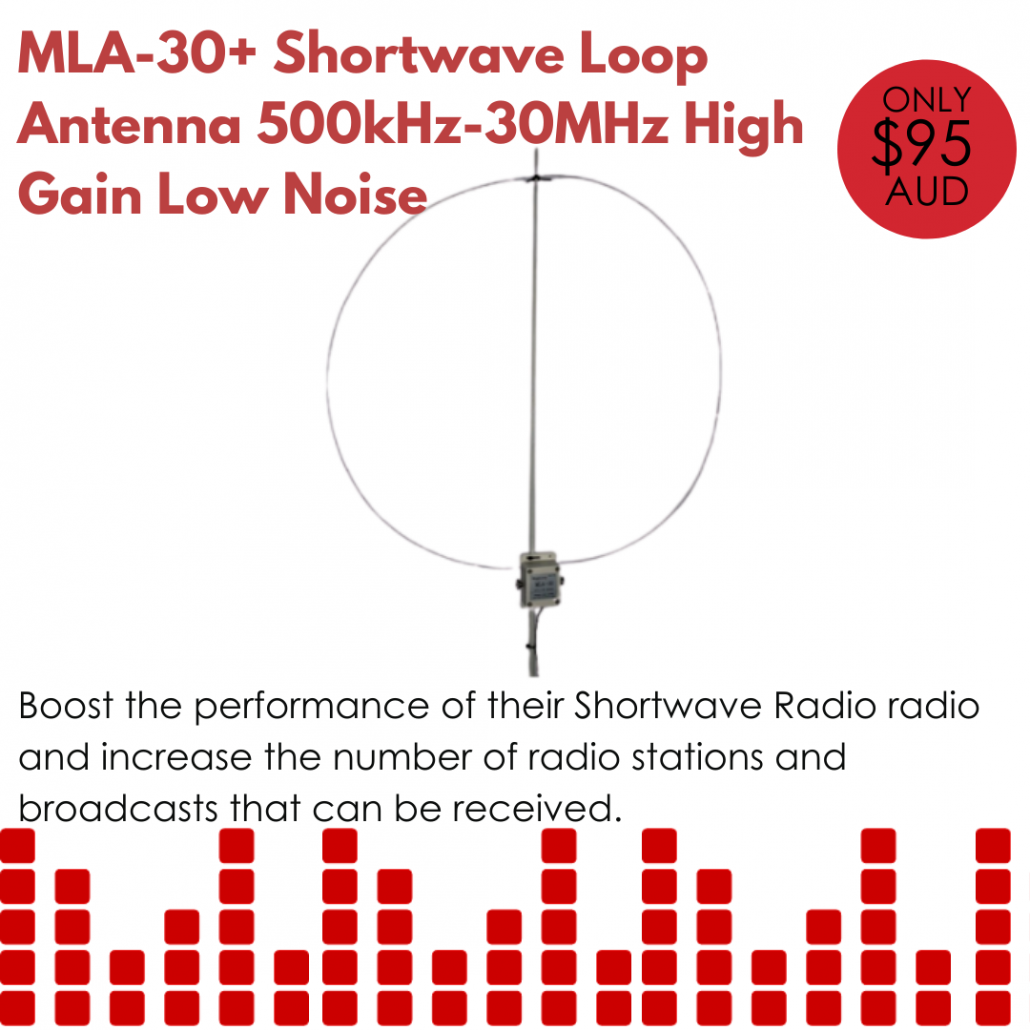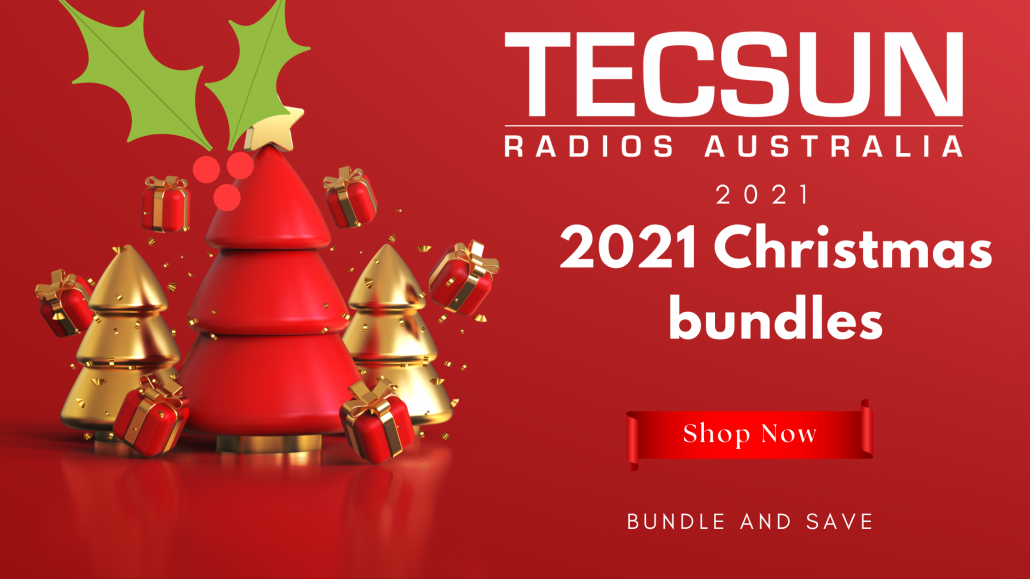 Yes, it is the season of giving! With holidays coming up it is also the time for exploring your hobbies and creating your own space to do more of the things you enjoy
Yes, it is the season of giving! With holidays coming up it is also the time for exploring your hobbies and creating your own space to do more of the things you enjoy
If this year has taught us anything, making sure your home is as comfortable as possible is paramount.
If you have dabbled in shortwave in the past and enjoyed it, perhaps now is the time to invest in this fantastic hobby and expand your horizons!!
We have created some fantastic bundle packs that are not only great as a gift idea but are also great suggestions to set yourself up for the years ahead with some awesome radio listening!! Receive huge discounts when you buy these products at the same time, simply add items to the cart and use the above code at checkout to get your discount!Welcome to the world of internet radio.
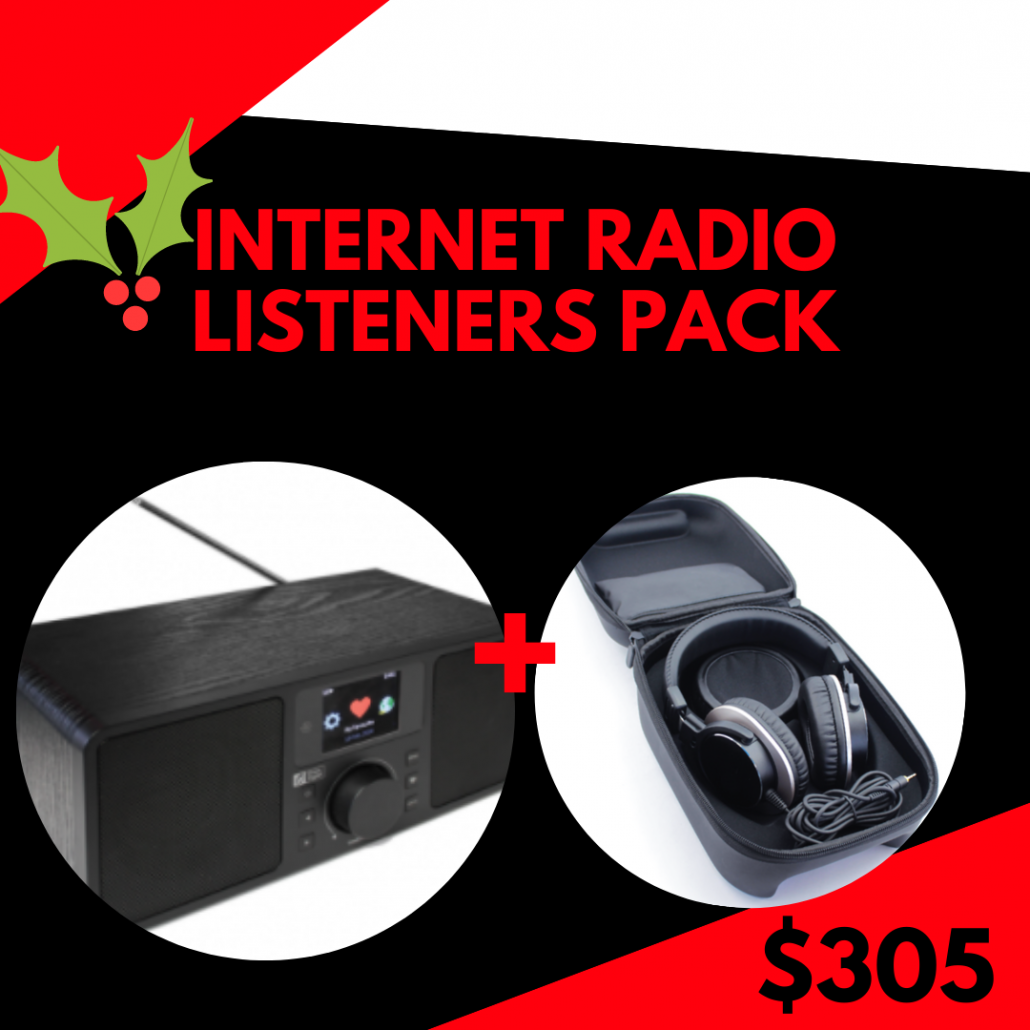
Internet Radio listening pack.Already a shortwave enthusiast but want to optimise your shortwave listening to world wide online stations too? This is the perfect pack featuring our stylish Apogee internet radio used in combination with our HiFi communication headphones for comfort and clarity! Simply connect to your existing internet service. You can turn up the music and not bother anyone else in your home!
Deal price $305 Normally $345
Travellers Companion Pack
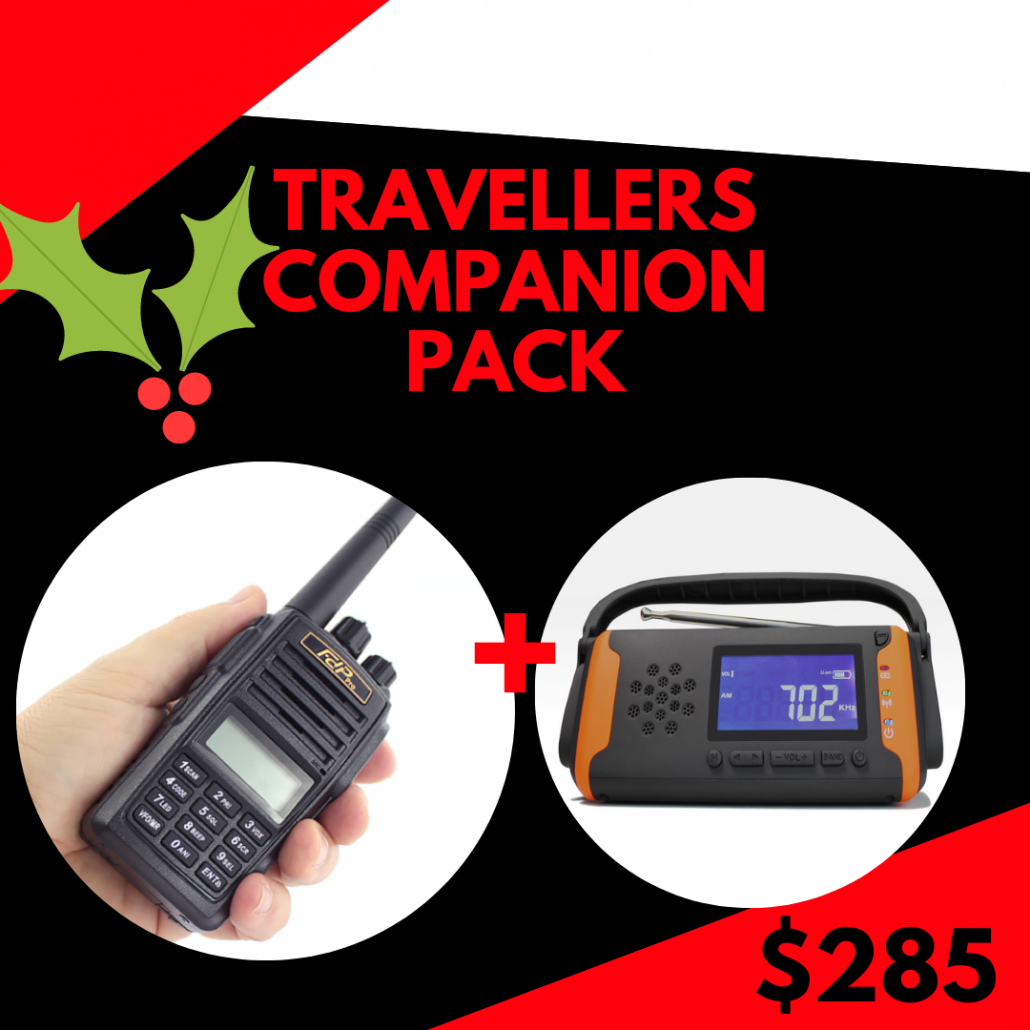
The FDPRO is perfect for travelling. Keep in touch with others in your immediate area, buy two units and keep in touch with the kids. Ideal for car to car communications, yet with the flexibility to keep in your grab bag in case of emergencies. Keep in touch over the CB band when you are on the go.
Accompany this with an Emergency radio that contains USB charger, emergency alarm and flashlight and you are set for the road and prepared for anything.
The perfect gift for people who may be about to hit the road travelling around Australia, those who live in rural areas or people who love to go camping and get out and about in nature.
Deal price $285, normally $305The DRM Pack
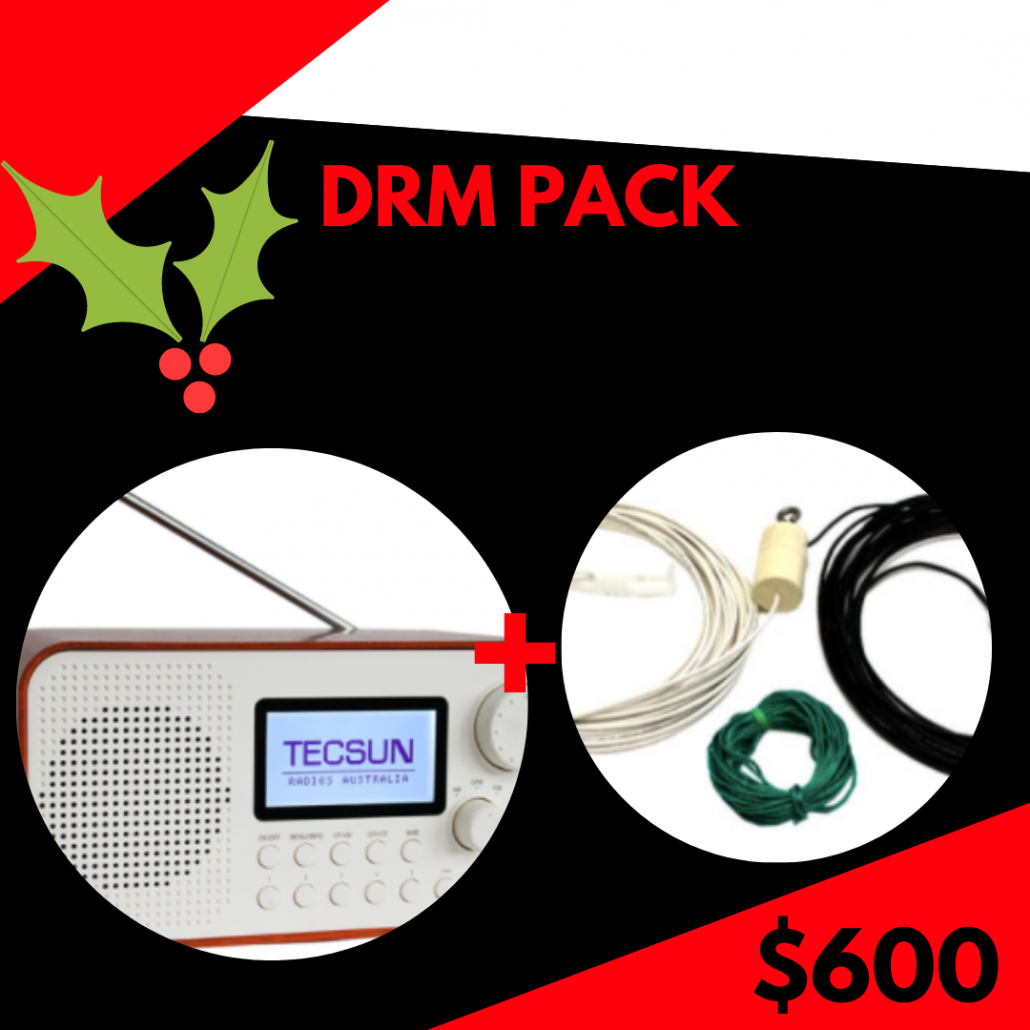
This fantastic pack broadens your listening to the digital radio world allowing you to both listen to shortwave and receive and decode DRM Shortwave Radio signals
Finally, a stand-alone Digital Radio Mondiale (DRM) Shortwave Radio has arrived and is available for DRM and shortwave radio enthusiasts to add to their collection.
The TRA Q-3061 DRM Shortwave Radio has been a long time coming and after evaluating dozens of samples over the years we have finally found a stand-alone desktop DRM radio that is suitable for Australian, New Zealand, and Pacific Islands listeners.
The TRA Q-3061 DRM Shortwave Radio is primarily designed to receive and decode DRM Shortwave Radio signals but the radio can also be used to receive traditional Shortwave (AM) broadcasts, FM, and AM (MW) broadcasts. The Tecsun Radios Australia Q-3061 DRM Shortwave Radio receives DRM, FM, and Shortwave (AW) signals via the inbuilt telescopic antenna, or for superior reception, the radio provides two dedicated external antenna BNC connections for DRM, Shortwave (AM), FM, and AM (MW) signals. On the FM band, this receiver also decodes RDS where broadcast. In slow tuning mode, the frequency step is reduced to 1 kHz. This is an advantage when tuning the extended MW band (530-1710 kHz) to receive specialised broadcasters in Australia.
The TRA Q-3061 DRM Shortwave Radio is for experienced shortwave users. There is a limited number of DRM signals available in our region although the total number of DRM broadcasts are increasing. This radio is squarely aimed at radio enthusiasts and DXers, most signals require an external antenna, experience, and patience.Included in this pack is the reception boosting Tecsun Shortwave and AM Outdoor Antenna which significantly enhances the reception of signals in the medium wave (AM) and shortwave antenna bands covering 0.5-30 MHz. The Tecsun Shortwave and AM Outdoor Antenna is based on a long wire antenna design but provides significantly improved reception over a long wire because the Tecsun Shortwave and AM Outdoor Antenna utilises a matching transformer that acts as a balun with a ratio of 10:1.
This pack is $600, normally $640Complete Hobby Radio Shack Pack.
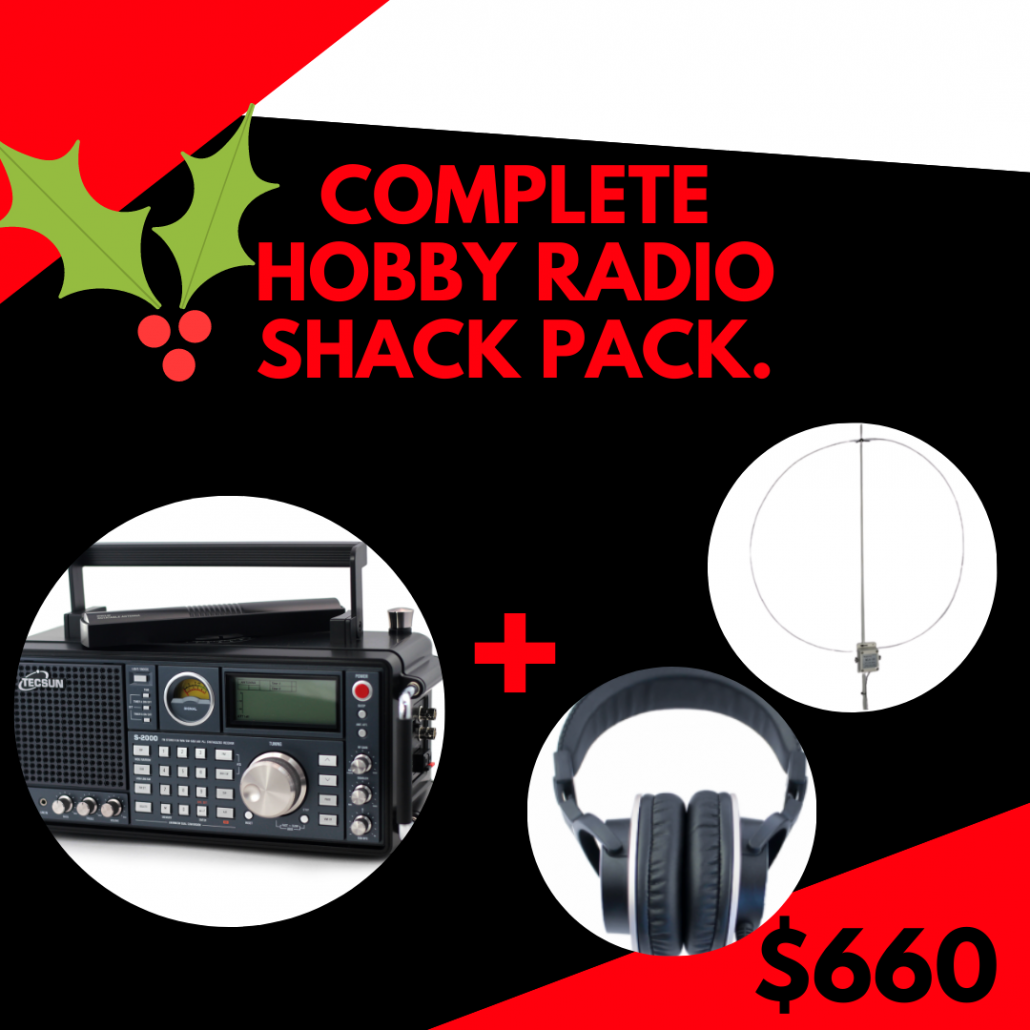
Receive huge discounts when you buy these products at the same time, simply add items to the cart and use the above code at checkout to get your discount!Go on, you deserve it. You have worked hard your whole life and now is the time you can dedicate to exploring the fantastic hobby that is shortwave. Beyond a man cave, a radio shack is a place you go to tinker, to tune and to uncover some of the world’s mysteries within one of the oldest hobbies around!!To complete your radio shack we recommend the following bundleThe S2000, a quality desktop radio that not only looks the part with its classic styling it also will enable you to tune in to SW, MW, AM and FM to follow your favourite stations and perhaps happen across a new broadcast you have ever heard before!Included in this bundle is the MLA-30+ Shortwave Loop Antenna that can be mounted indoors to boost the performance of your Shortwave radio and increase the number of radio stations and broadcasts that can be received.Once you have found your favourite stations simply program them into your S2000 and add your final accessory for the best and most comfortable listening possible. A pair of Tecsun hifi communication headphones. and add your final accessory for the best listening possible. Some Tecsun hifi communication headphones.Bundle and save, deal price $660, normally $710 when all 3 purchased together in one checkout.For those serious about Ham Radio
The New Ham
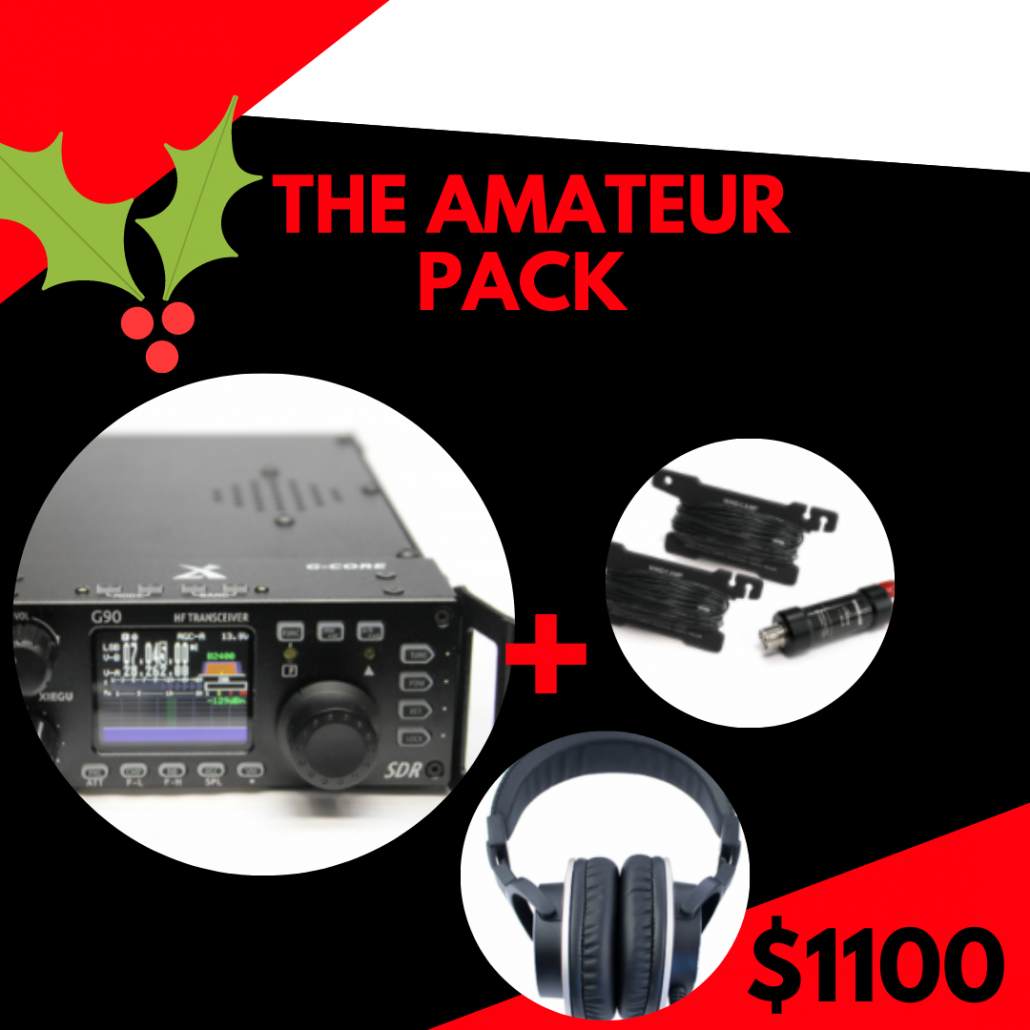
This pack contains everything you need to listen to shortwave radio.
Xiegu G90 + Antenna +Headphones Only $1100, normally $1167The star of this pack is the Xiegu G90, truly a world class radio transceiver. The XIEGU G90 HF Transceiver is a High-Performance Portable Amateur Radio Transceiver. This powerful portable HF multimode transceiver covers 0.5-30MHz (10-160 metres on TX) with 20 watts of RF output. The XIEGU G90 HF Transceiver utilises a software-defined (SDR) 24-bit architecture to provide superb transmit and receive performance.Use the supplied separation cable to mount the control head where you can see it and the transceiver out of the way, to maximise operating room in your radio shack.Improve your reception with The TRA HF Portable Dipole antenna is rated at 100 Watts PEP power handling capability. Featuring 10 metres of Rg58 cable for easy connection to most transceivers.Note: Best results will be obtained when the antenna is at least 4 metres above ground. In theory, the antenna should be at least a quarter wavelength above the ground for best results, so the height will correspond to the operating band. Generally, higher is better.Your final accessory in this pack is for the best and most comfortable listening possible in your radio shack. A pair of Tecsun hifi communication headphones. With memory foam ear covers and an extra-long cord to reach your radios.Bundle price $1100, normally $1167
OFFER VALID TILL MIDNIGHT DEC 24.
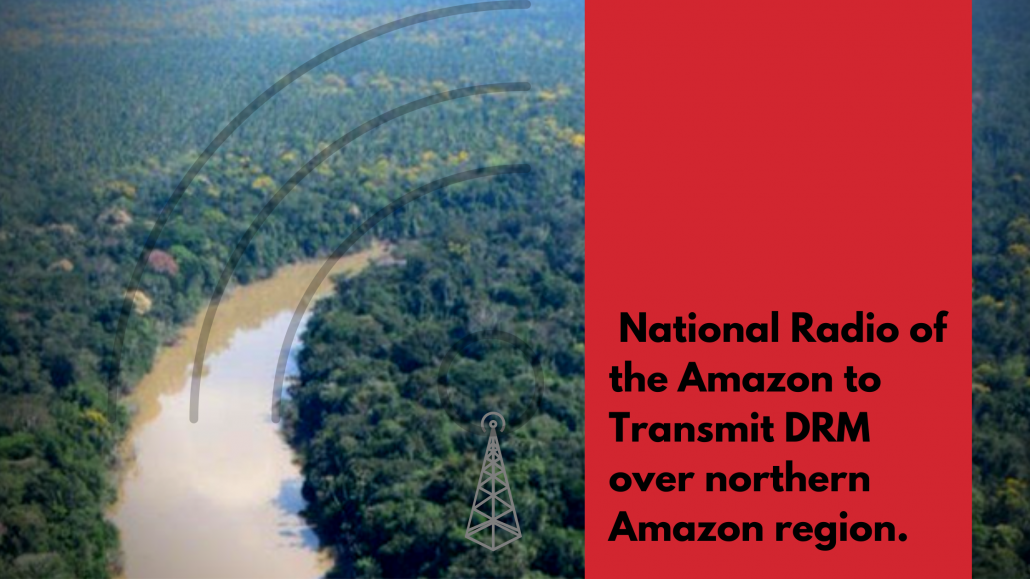
The People of the Amazon will soon be covered by DRM shortwave as National Radio of the Amazon orders a 100 kW BT transmitter
The vast area of the Amazon known as the Amazon Rainforest is the largest tropical ecosystem in the world, with rainforest covering roughly 40% of South America, stretching over ten countries in South America, and is almost as large as the United States! The rainforest is home to both large and small communities in very remote areas, some harvesting crops along the rivers and others in more secluded villages deep within the forests.
As you can imagine communication to these areas can be difficult so it was no surprise when at the end of last year, testing of DRM technology began using a transmitter of 2.5 kW with the digital power of just 1 kW.
Despite this low power of the transmitter supplied by BT Transmitters, recordings were reported from different regions of the country and even from North America and Europe.
As a result of these tests, the National Radio of the Amazon decided to use DRM shortwave transmissions to serve indigenous populations in the northern Amazon region.
At the sizable cost of $650,000 USD. Public broadcaster Empresa Brasil de Comunicação (EBC) ordered a 100 kW BT transmitter to broadcast in DRM at 11,780 kHz in the 25-meter band, an existing shortwave channel used by Rádio Nacional da Amazônia.
This is considered to be the first domestic DRM installation on a locally produced transmitter in Latin America.
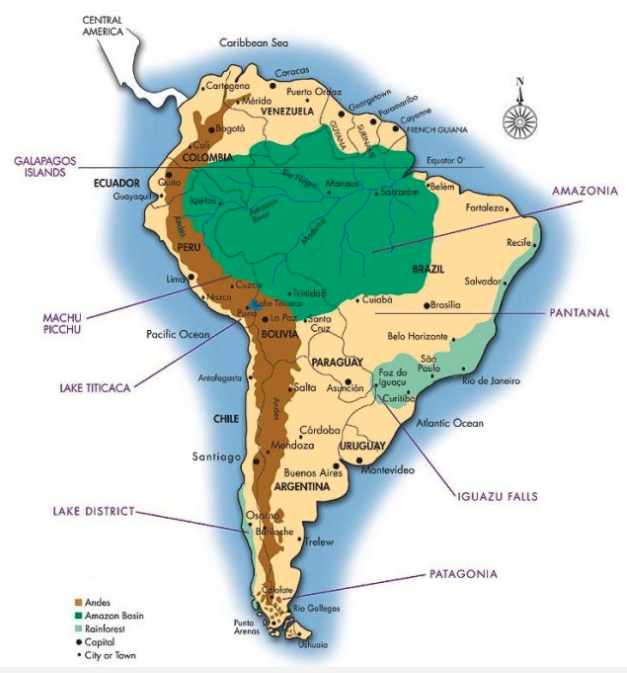
Information from The Digital Radio Mondiale Consortium.
Image via https://amazonaid.org/
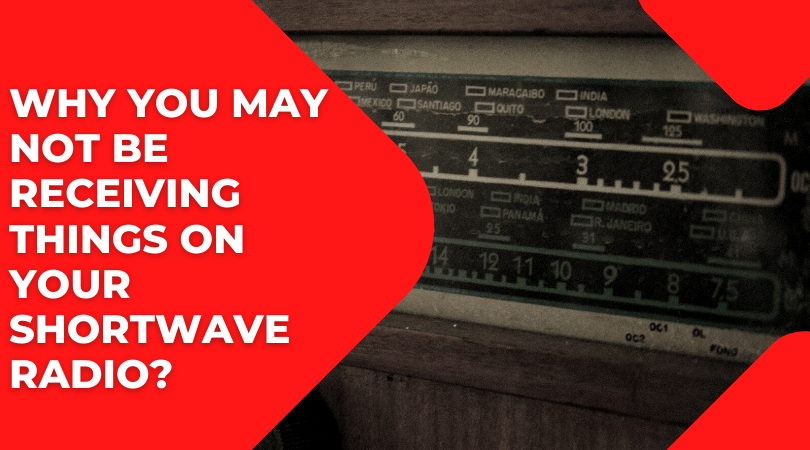
You just got your new radio. You excitedly unbox it and put in your Tecsun batteries, you turn it on, and there’s the sweet sound of….. Silence 🙁
What could be wrong? Is my radio broken?
Chances are it is not broken, here are several things it may be.
The first one may be noise, yes noise! Unfortunately, every single electrical item in your home emits a frequency, particularly modern items, especially if you live in a densely populated area. There may simply be too much noise dominating your area.
If you have a portable radio you could try troubleshooting it yourself. Simply walk around the home to find where you receive a signal and also where it is being interfered with. We had one customer just the other week who did this and realised the light dimmers were creating interference, light dimmers!! Sometimes it’s the microwave, sometimes it’s a power outlet. Radio signals cannot penetrate the metal walls of your shed, nor the foil-lined roof of your house! Taking the radio outdoors to try and receive a signal is one way of eliminating the effects of interference. If this is successful, the next step is to investigate an external antenna.
The Tecsun Outdoor Shortwave and Medium Wave Antenna is one solution. This gets the receiving ‘element” further away from the noise source, it is then matched to the transmission line and the radio is then fed with a coaxial cable. Compared to a straight piece of wire of the same length, this antenna offers a huge improvement in received signal level. If you do not have room for an external antenna, an “active loop” antenna might be your solution. These can be erected on a balcony or even fixed tothe glass of a window.
Another reason you may not be receiving shortwave is the time of day. Unless the specific broadcast is aimed at Australia, most international shortwave broadcasts will occur during daylight hours for the listening audience. So depending on the broadcaster, this might be in the middle of the night for us shortwave enthusiasts. Check some of the available shortwave radio schedules on the internet to see who is broadcasting when you are listening. In Australia, at this time of year there are many shortwave stations operating around 9Mhz most mornings, by mid-afternoon, many have shifted to 13-18Mhz for the evening.
Time signals are one reliable signal source. They are on air constantly 24 hours a day. Their signals on 10.00Mhz and 15.00Mhz are easiest to hear, and this will confirm the correct operation of your receiver. These signals are also ideal for comparing reception results between antennas. It is also possible to check the signal of a shortwave broadcaster using the Tecsun Radios online SDR. Click here for access.
Perhaps during the time you are tuning there is a geomagnetic storm or a solar flare that may be causing a temporary weakened signal.
It may be that a setting on your radio needs changing. Many radios have a button for “local or DX”. If your switch is on local it may not receive weaker stations.
Experiencing issues setting up your shortwave radio ? Garry at Tecsun Radios Australia is here to help guide you through the troubleshooting process if needed.
It is all part of why we are different here at Tecsun Radios Australia.
In fact with every radio purchase from Tecsun Radios Australia, you receive a listeners guide which includes a very comprehensive and practical guide to locating sources of AM and HF interference! You can view this guide here
The main thing to remember is dont give up ! Shortwave listening is like fishing, you never know what you are going to catch! Equipping yourself with a good receiver and antenna, are the first steps towards being able to regularly enjoy shortwave listening, the only live and uncensored source of international news and events.
One of our most popular portable shortwave radios is the Tecsun PL880. It comes in both the original and the deluxe edition with a stylish and durable hard case to keep your radio safe, shockproof, and moisture-free in storage or whilst traveling.
The top features of the PL880 are digital signal processing on the HF band (in all modes), a quantum leap forward for the reception of weak signals. In addition, the Tecsun PL880 Radio offers 9 user-selectable IF bandwidth settings for communications enthusiasts, and a new long-life lithium-ion battery.
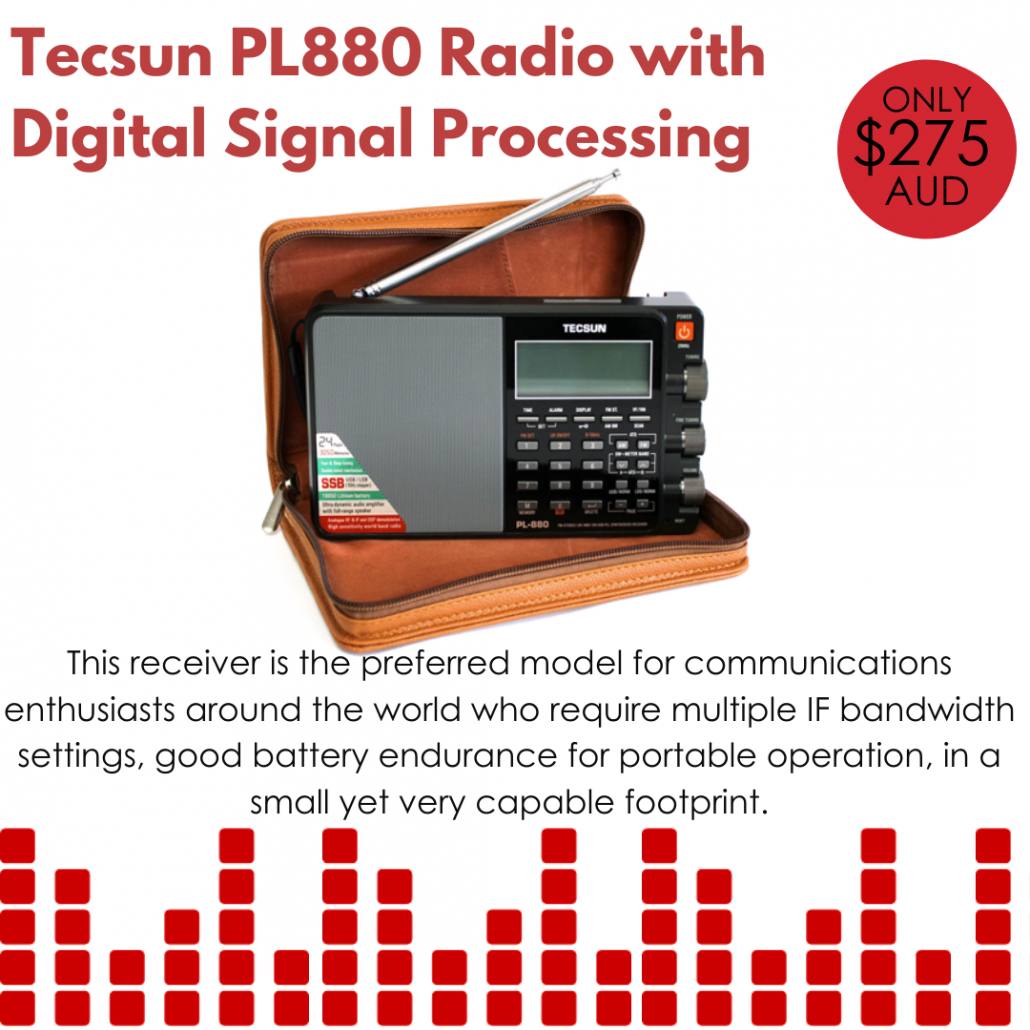
The receiver covers the entire shortwave range (100-29999KHz), Longwave, FM and AM broadcast bands. Receiver sensitivity on HF in the SSB mode is typically less than 1uV. Upper Side Band and Lower Side Band are individually selectable, and there are multiple user-selectable bandwidth settings available for each band.* The receiver is equipped with an external antenna socket to allow connection of an external antenna for the Shortwave bands for enhanced reception.
Speaking of External antennas. To improve your reception we highly recommend the Tecsun shortwave and AM outdoor antenna.
The Tecsun Shortwave and AM Outdoor Antenna significantly enhances the reception of signals in the medium wave (AM) and shortwave antenna bands covering 0.5-30 MHz. The Tecsun Shortwave and AM Outdoor Antenna is based on a 10 metre longwire antenna design but provides significantly improved reception over a basic longwire because it utilises a matching transformer that acts as a balun with a ratio of 9:1. This provides an optimal match between the 500 ohm impedance of the antenna and the 50 ohm impedance of the receiver, greatly increasing the amount of signal provided to the tuner.
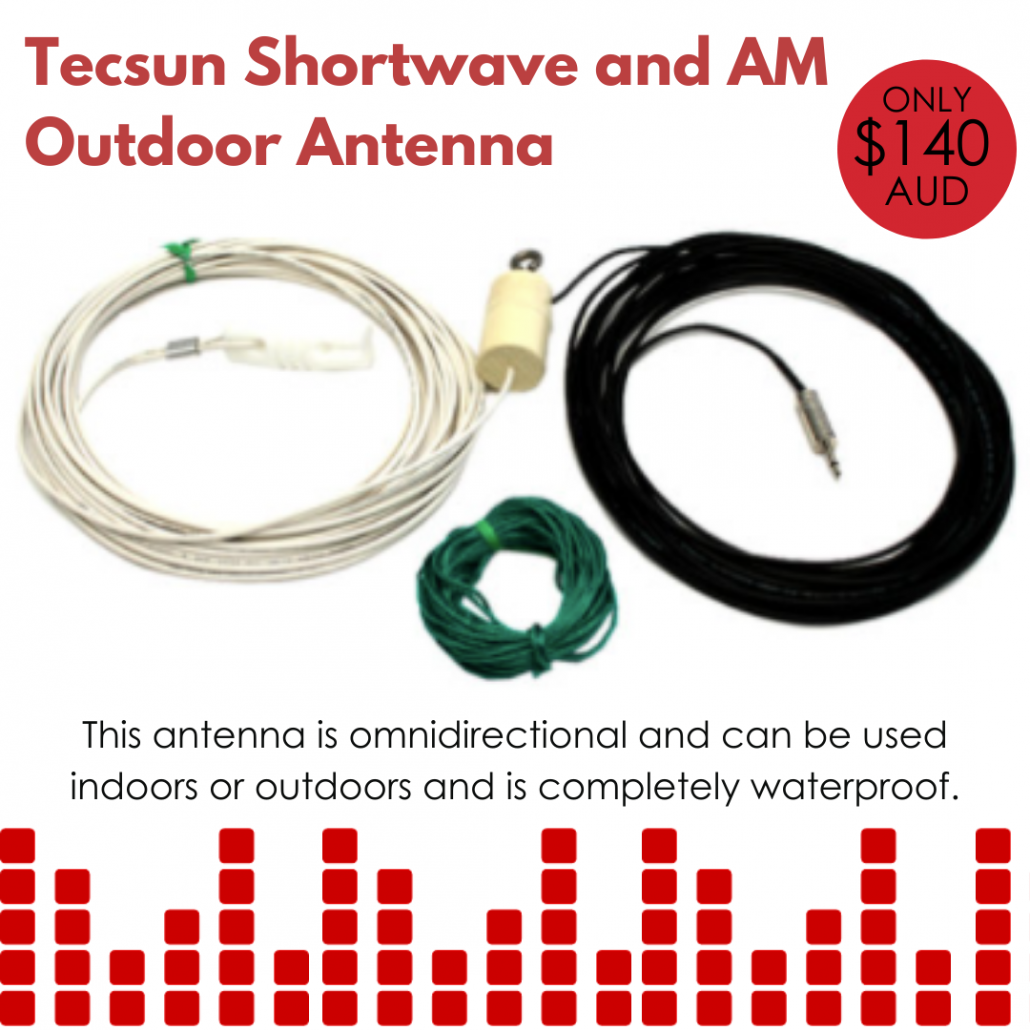
The MLA-30+ The MLA-30+ Shortwave Loop Antenna is an affordable active loop antenna that allows people without the luxury of a large backyard, to use an external antenna to boost the performance of their Shortwave Radio radio and increase the number of radio stations and broadcasts that can be received. The MLA-30+ Shortwave Loop Antenna can be mounted indoors on any non-conductive rod or tube, such as PVC conduit or fibreglass rod (not metal). The loop element of the MLA-30+ Shortwave Loop Antenna has a diameter of 60cm and is connected to the active amplifier housing by two stainless steel wing nuts. For portable operation, the MLA-30+ Shortwave Loop Antenna can be powered by a standard USB powerbank.
